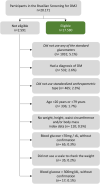Prevalence of people at risk of developing type 2 diabetes mellitus and the involvement of community pharmacies in a national screening campaign: a pioneer action in Brazil
- PMID: 33062060
- PMCID: PMC7545923
- DOI: 10.1186/s13098-020-00593-5
Prevalence of people at risk of developing type 2 diabetes mellitus and the involvement of community pharmacies in a national screening campaign: a pioneer action in Brazil
Abstract
Background: Brazil is one of top 10 countries with the highest number of people with diabetes mellitus (DM), affecting 16.8 million peoples. It is estimated that 7.7 million people (20-79 years) in the country have not yet been diagnosed, representing an under-diagnosis rate of 46.0%. Herein we aimed to screen people for high blood glucose or risk for developing type 2 DM (T2DM) through community pharmacies in Brazil.
Methods: A cross-sectional study was carried out in November 2018, involving 977 pharmacists from 345 municipalities in Brazil. The study evaluated people between 20 and 79 years old without a previous diagnosis of DM. Glycemia was considered high when its value was ≥ 100 mg/dL fasting and ≥ 140 mg/dL in a casual feeding state. The FINDRISC (Finnish Diabetes Risk Score) was used to estimate the risk for developing T2DM. The prevalence of high blood glucose was estimated and the associated factors were obtained using Poisson's multivariate analysis with robust variance.
Results: During the national screening campaign, 17,580 people were tested with the majority of the consultations (78.2%) being carried out in private pharmacies. The population was composed mainly of women (59.5%) and people aged between 20 and 45 years (47.9%). The frequency of participants with high blood glucose was 18.4% (95% CI 17.9-19.0). Considering the FINDRISC, 22.7% of people had a high or very high risk for T2DM. The risk factors associated with high blood glucose were: Body Mass Index > 25 kg/m2, abdominal circumference > 94 cm for men and > 80 cm for women; education level below 15 years of study, no daily intake of vegetables and fruits; previous diagnosis of arterial hypertension; history of high blood glucose and family history of DM.
Conclusions: This is the largest screening study that evaluated the frequency of high blood glucose and its associated factors in a population without a previous diagnosis ever performed in community pharmacies in Brazil. These results may help to improve public health policies and reinforce the role of pharmacists in screening and education actions aimed at this undiagnosed population in a continent-size country such as Brazil.
Keywords: Chronic disease; Diabetes mellitus; Prevalence; Risk factors.
© The Author(s) 2020.
Conflict of interest statement
Competing interestsThere are no competing interests to declare.
Figures
References
-
- Lozano R, Naghavi M, Foreman K, Lim S, Shibuya K, Aboyans V, et al. Global and regional mortality from 235 causes of death for 20 age groups in 1990 and 2010: a systematic analysis for the Global Burden of Disease Study 2010. Lancet. 2012;380:2095–2128. doi: 10.1016/S0140-6736(12)61728-0. - DOI - PMC - PubMed
-
- International Diabetes Federation. IDF Diabetes Atlas Ninth edition. 2019. https://www.diabetesatlas.org/en/. Accessed 16 Jun 2020.
-
- Brasil. VIGITEL Brasil 2017 Vigilância de fatores de risco e proteção para doenças crônicas por inquérito telefônico. 2017. https://bvsms.saude.gov.br/bvs/publicacoes/vigitel_brasil_2017_vigilanci.... Accessed 08 Apr 2018. - PubMed
LinkOut - more resources
Full Text Sources



